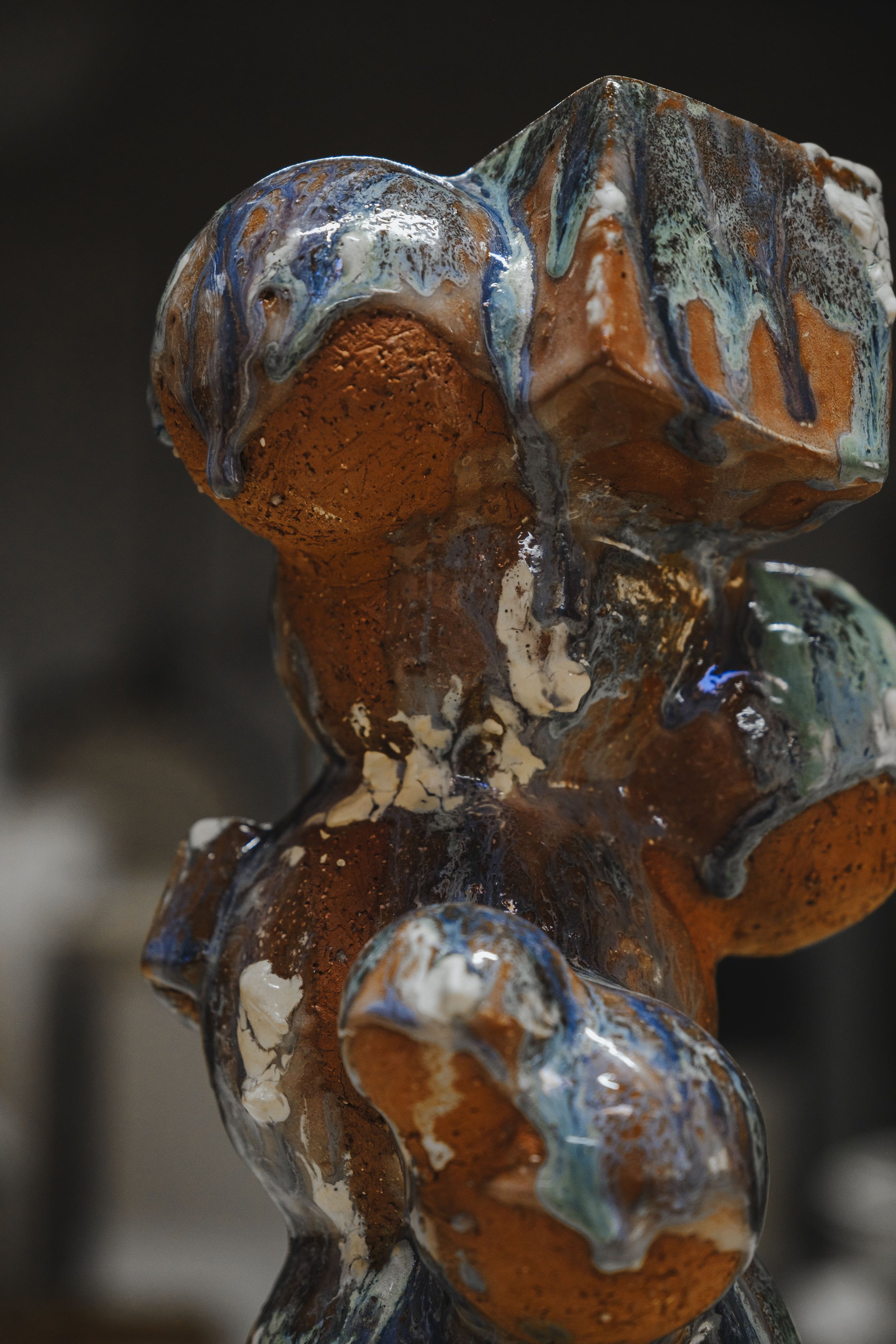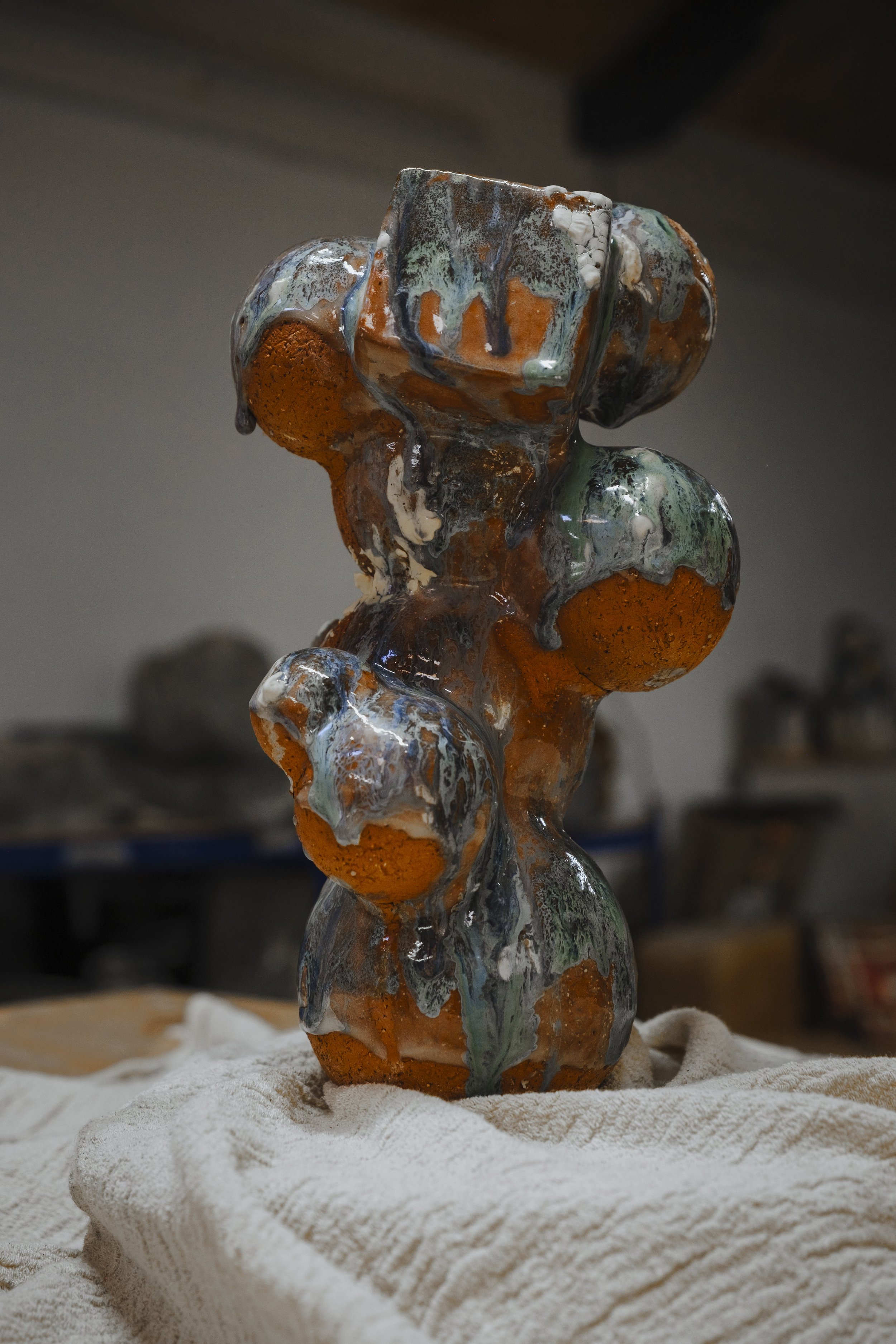Chaos
Chaos is a sculptural piece that embodies the principles of chaos theory, illustrating how intricate, interconnected forms can arise from simple geometric shapes. Made from terracotta clay, the sculpture consists of a network of linked cubes and spheres, each form representing fundamental building blocks of structure. The surface is finished with mixed, random glazes that are allowed to flow and undulate, creating a dynamic and unpredictable visual effect that mirrors the underlying chaos and order of natural systems.
Form and Symbolism:
Cubes and Spheres: The sculpture is constructed from a combination of cubes and spheres, basic geometric shapes that symbolize simplicity and foundational elements in both art and science. The cubes represent order, stability, and structure, while the spheres symbolize unity, fluidity, and infinite potential. Their combination in this piece represents the interplay between order and chaos, showing how simple forms can create complex systems when connected in varied ways.
Interconnected Network: The cubes and spheres are linked together in an intricate, seemingly random network that extends in all directions, mimicking the fractal nature of chaos theory. This network suggests the interconnectedness of all things and the way small changes in a system can lead to large-scale complexity. The structure grows organically, expanding outward in an unpredictable manner, much like natural forms found in the physical world.
Terracotta Clay Body: Made from terracotta clay, the sculpture has a warm, earthy color that grounds it in a natural, organic aesthetic. The clay's texture adds a tactile element to the piece, emphasizing the rawness and authenticity of the materials used. Terracotta, with its historical significance and natural origins, also connects the work to traditional craftsmanship and the fundamental elements of the earth.
Mixed Random Glazes: The surface of the sculpture is finished with a variety of glazes, applied randomly to allow colors to mix, flow, and react unpredictably across the terracotta forms. These glazes course and undulate over the surface, creating rivers of color and texture that mimic the behavior of chaotic systems in nature. The randomness of the glaze application reflects the concept of initial conditions leading to unpredictable outcomes, a core idea in chaos theory.
Cultural and Scientific Context:
Chaos theory, a branch of mathematics, describes systems that are highly sensitive to initial conditions, leading to behavior that appears random or chaotic, yet follows deterministic rules. This sculptural piece captures the essence of chaos theory by using simple geometric shapes and unpredictable glaze patterns to create a complex and interconnected form.
The use of terracotta and mixed glazes connects the piece to both ancient ceramic traditions and modern scientific concepts, bridging the gap between art, nature, and science. The sculpture serves as a visual representation of how complexity can emerge from simplicity, encouraging viewers to contemplate the underlying patterns and connections in the world around them.
Interpretation and Use:
Chaos is a statement piece that invites viewers to explore the relationship between order and chaos, simplicity and complexity. It can be placed in a gallery, museum, or private collection as an artistic interpretation of scientific principles, sparking dialogue about the nature of systems, structures, and the unpredictability of the universe.
The dynamic form and glaze patterns draw the eye, inviting close examination and reflection on the interplay of shapes, colors, and textures. As an object of contemplation, the sculpture encourages viewers to consider how simple elements combine to create the complex, interconnected world we experience.
Chaos is a sculptural piece that embodies the principles of chaos theory, illustrating how intricate, interconnected forms can arise from simple geometric shapes. Made from terracotta clay, the sculpture consists of a network of linked cubes and spheres, each form representing fundamental building blocks of structure. The surface is finished with mixed, random glazes that are allowed to flow and undulate, creating a dynamic and unpredictable visual effect that mirrors the underlying chaos and order of natural systems.
Form and Symbolism:
Cubes and Spheres: The sculpture is constructed from a combination of cubes and spheres, basic geometric shapes that symbolize simplicity and foundational elements in both art and science. The cubes represent order, stability, and structure, while the spheres symbolize unity, fluidity, and infinite potential. Their combination in this piece represents the interplay between order and chaos, showing how simple forms can create complex systems when connected in varied ways.
Interconnected Network: The cubes and spheres are linked together in an intricate, seemingly random network that extends in all directions, mimicking the fractal nature of chaos theory. This network suggests the interconnectedness of all things and the way small changes in a system can lead to large-scale complexity. The structure grows organically, expanding outward in an unpredictable manner, much like natural forms found in the physical world.
Terracotta Clay Body: Made from terracotta clay, the sculpture has a warm, earthy color that grounds it in a natural, organic aesthetic. The clay's texture adds a tactile element to the piece, emphasizing the rawness and authenticity of the materials used. Terracotta, with its historical significance and natural origins, also connects the work to traditional craftsmanship and the fundamental elements of the earth.
Mixed Random Glazes: The surface of the sculpture is finished with a variety of glazes, applied randomly to allow colors to mix, flow, and react unpredictably across the terracotta forms. These glazes course and undulate over the surface, creating rivers of color and texture that mimic the behavior of chaotic systems in nature. The randomness of the glaze application reflects the concept of initial conditions leading to unpredictable outcomes, a core idea in chaos theory.
Cultural and Scientific Context:
Chaos theory, a branch of mathematics, describes systems that are highly sensitive to initial conditions, leading to behavior that appears random or chaotic, yet follows deterministic rules. This sculptural piece captures the essence of chaos theory by using simple geometric shapes and unpredictable glaze patterns to create a complex and interconnected form.
The use of terracotta and mixed glazes connects the piece to both ancient ceramic traditions and modern scientific concepts, bridging the gap between art, nature, and science. The sculpture serves as a visual representation of how complexity can emerge from simplicity, encouraging viewers to contemplate the underlying patterns and connections in the world around them.
Interpretation and Use:
Chaos is a statement piece that invites viewers to explore the relationship between order and chaos, simplicity and complexity. It can be placed in a gallery, museum, or private collection as an artistic interpretation of scientific principles, sparking dialogue about the nature of systems, structures, and the unpredictability of the universe.
The dynamic form and glaze patterns draw the eye, inviting close examination and reflection on the interplay of shapes, colors, and textures. As an object of contemplation, the sculpture encourages viewers to consider how simple elements combine to create the complex, interconnected world we experience.


